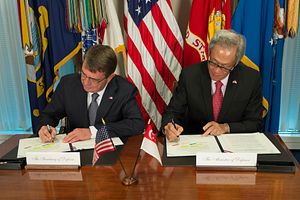As my colleague Prashanth Parameswaran noted yesterday, the United States and Singapore just signed an enhanced defense cooperation agreement. The agreement covered a wide range of areas, including expanded defense dialogues and increased cooperation on cybersecurity and counterterrorism. However, the announcement that garnered the most attention was the news that Singapore will allow U.S. surveillance aircraft to operate from the city-state. A U.S. P-8 Poseidon aircraft will be deployed in Singapore from December 7 to 14 – and it is widely expected to be used in part to keep tabs on China’s activities in the South China Sea.
China was none too happy with the agreement. Foreign Ministry spokesperson Hua Chunying told reporters that “the overall situation in the South China Sea is peaceful and stable,” just as regional countries want. “Against a backdrop as such, is military deployment and regional militarization by the U.S. in line with the aspiration shared by countries in the region?” Hua asked. She immediately answered the question on China’s behalf: “In our point of view, it goes against the common and long-term interests of countries in the region.”
It’s interesting that Hua takes the United States to task for “regional militarization” without laying any blame on Singapore, which agreed to host the U.S. deployment of a P-8 surveillance aircraft (and already hosts U.S. littoral combat ships). After all, Chinese President Xi Jinping was in Singapore for a state visit just a month ago. Chinese officials, hoping to smooth relationships damaged by the South China Sea disputes, cited the friendly China-Singapore relationship as a potential model for China-ASEAN ties. That adds an extra twist to the announcement made this week, during Singapore Defense Minister Ng Eng Hen’s visit to Washington, D.C.
For Singapore, however, there’s no paradox. A careful balancing act between the United States and China is seen as the best avenue to securing the country’s interests.
As is the case for many Southeast Asian states, China is Singapore’s largest trading partner, with two-way trade totaling $86 billion in 2014. Singapore is the most popular destination for Chinese investments in Asia. Meanwhile, Singapore has been the largest foreign investor in China for the past two years.
Yet since the beginning of China-Singapore diplomatic relations, Singapore has been nervous about being seen as unduly close to (or reliant on) China; The Straits Times notes that the country delayed establishing diplomatic relations with China by nearly 15 years so that it could be the last of the original five ASEAN states to do so. Meanwhile, Singapore has kept up a robust defense relationship with the United States. The joint statement issued by Ng and U.S. Secretary Defense Ash Carter spoke of a “shared belief that a strong United States presence in the Asia-Pacific is vital for peace, prosperity and stability.”
Singapore also has expressed its concerns about the unfolding situation in the South China Sea; the move to host U.S. P-8 surveillance plans is a relatively low-risk way to conveying the seriousness of Singapore’s concerns to China while also reinforcing the Singapore-U.S. defense relationship.
Singapore and the United States avoided linking the P-8 deployment directly to the South China Sea disputes. Instead, they explained the deployment in terms of relationship-building and providing humanitarian assistance and disaster relief (HADR). Carter and Ng “noted that the aircraft’s deployment would promote greater interoperability with regional militaries through participation in bilateral and multilateral exercises, while providing timely support for regional HADR and maritime security efforts,” the joint statement said.
China has also defended its actions in the South China Sea, particularly its island-building and construction projects, as providing HADR and civilian services, rather than being an example of “militarizing” the disputed region. Hua’s comments on the U.S.-Singapore defense agreement are just the latest case of China and the United States trading accusations of militarization, while each side defends its own actions as necessary and proper.

































